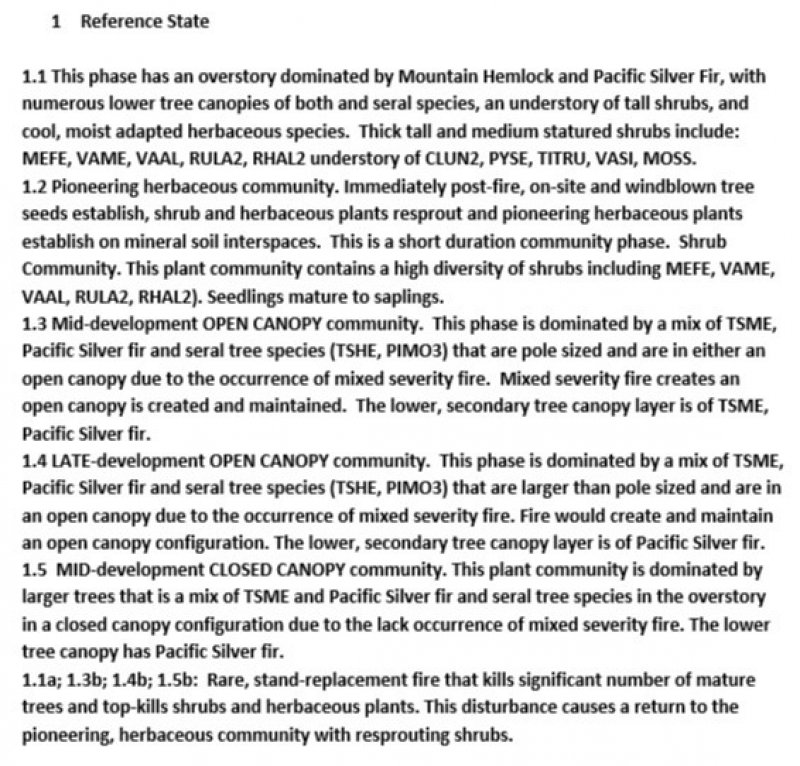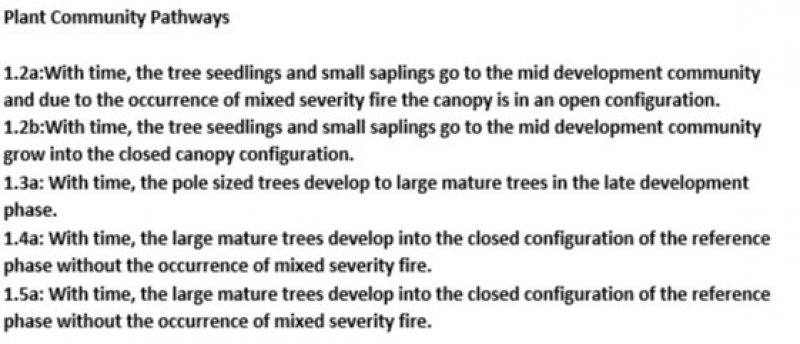
Natural Resources
Conservation Service
Ecological site F006XB002WA
Cold Cryic Udic Mountain Slopes (Mountain Hemlock Cold Moderately Moist Shrub/Herb)
Last updated: 2/14/2025
Accessed: 12/21/2025
General information
Provisional. A provisional ecological site description has undergone quality control and quality assurance review. It contains a working state and transition model and enough information to identify the ecological site.
MLRA notes
Major Land Resource Area (MLRA): 006X–Cascade Mountains, Eastern Slope
Major Land Resource Area (MLRA): 006X–Cascade Mountains, Eastern Slope.
Stretching from northern Washington to southern Oregon, MLRA 6 encompasses the mountain slopes, foothills, elevated plateaus and valleys on the eastern slopes of the Cascade mountains. This MLRA is a transitional area between the Cascade Mountains to the west and the lower lying Columbia Basalt Plateau to the east. Situated in the rain shadow of the Cascade Crest, this MLRA receives less precipitation than portions of the cascades further west and greater precipitation than the basalt plateaus to the east. Geologically, the majority of the MLRA is dominated by Miocene volcanic rocks, while the northern portion is dominated by Pre-Cretaceous metamorphic rocks and the southern portion is blanketed with a thick mantle of ash and pumice from Mount Mazama. The soils in the MLRA dominantly have a mesic, frigid, or cryic soil temperature regime, a xeric soil moisture regime, and mixed or glassy mineralogy. They generally are moderately deep to very deep, well drained, and loamy or ashy. Biologically, the MLRA is dominated by coniferous forest, large expanses of which are dominated by ponderosa pine, Douglas-fir or lodgepole pine. Areas experiencing cooler and moister conditions include grand fir, white fir, and western larch while the highest elevations include pacific silver fir, subalpine fir and whitebark pine. Economically, timber harvest and recreation are important land uses in these forests. Historically, many of these forests would have experienced relatively frequent, low and mixed severity fire favoring the development of mature forests dominated by ponderosa pine or Douglas-fir. In the southern pumice plateau forests, less frequent, higher severity fire was common and promoted the growth of large expanses of lodgepole pine forests.
LRU notes
This ecological site typically resides on mountain slopes, at elevations of 3500 to 6000 feet, on slopes of 5 to 65 percent. The climatic conditions are moderately moist and cold, with 40 to 75 frost-free days, mean annual precipitation of 40 to 80 inches, and mean annual air temperature of 39 to 42 degrees Fahrenheit.
Classification relationships
CMS356 - Mountain hemlock/Cascade azalea-big huckleberry (TSME/RHAL-VAME) (WEN)
Ecological site concept
This ecological site typically resides on mountain slopes, at elevations of 3500 to 6000 feet, on slopes of 5 to 65 percent. The climatic conditions are moderately moist and cold, with 40 to 75 frost-free days, mean annual precipitation of 40 to 80 inches, and mean annual air temperature of 39 to 42 degrees Fahrenheit.
The soils are Andisols, specifically Humic or Xeric Vitricryands, with andic soil properties and an ashy-skeletal particle-size class. Surface textures are typically gravelly or cobbly ashy sandy loam or ashy loamy sand. The parent material is volcanic ash mixed with colluvium and residuum from volcanic rock. The soils are dominantly well drained, and have no flooding, ponding or water table. They are typically 20 to greater than 60 inches deep to a root-restricting feature. These soils have a cryic soil temperature regime and xeric or udic soil moisture regime.
The reference community has an overstory of TSME, with potentially high cover of ABAM and a diverse understory of cold adapted shrub and herbaceous species including: RHAL2, CLUN2, MEFE, PYROL, STAM2, VAME. Seral tree species include: ABAM, ABGR, ABLA, PIEN, LAOC, PICO, CUNO and in warmer, lower elevation areas PIMO3, THPL, TSHE, PSME.
This covers the mountain hemlock areas which span the highest forests, directly below subalpine parklands. These forests have a deep, persistent snowpack and short growing season. Fires occur frequently from lightning strikes, though most fires a very small, infrequently there are large stand replacing fires approximately every 300 years. Insect and disease impact these forests on small scales including heart and butt rot, root rot, bark beetles and others. This site covers the dominant cool moist condition of the mountain hemlock at the upper elevations there may be more heath species and avalanches may be a more dominant disturbance, reoccurring in the same areas repeatedly. The harsh site conditions define the ecological site and control the vegetation community and include a heavy, persistent snowpack that causes a short growing season. The reference community is predominantly Tsuga mertensiana, though Abies amabilis can have high canopy cover, the regenerating layer always has Tsuga mertensiana. The understory can vary from moist (MEFE, VAAL, VAME, VAOV, SOSI, CLUN2) to drier site adapted species (XETE, VACA, RHAL2, RUPE, PYSE) and at the highest elevation (PHEM).
Associated sites
| F006XA008WA |
Cryic Xeric Mountain Slopes (Subalpine fir Cold Moderately Dry Shrub/Herb) Drier sites. |
|---|
Similar sites
| F006XA006WA |
Cold Cryic Udic Mountain Slopes (Pacific Silver fir Cold Moist Shrub/Herb) Lower elevation. |
|---|
Table 1. Dominant plant species
| Tree |
(1) Tsuga mertensiana |
|---|---|
| Shrub |
(1) Rhododendron albiflorum |
| Herbaceous |
Not specified |
Click on box and path labels to scroll to the respective text.
Ecosystem states
State 1 submodel, plant communities
Communities 1, 5 and 2 (additional pathways)
| 1.1A | - | Rare, stand-replacement fire |
|---|---|---|
| 1.2A | - | Time |
| 1.2B | - | Time |
| 1.3B | - | Rare, stand-replacement fire |
| 1.3A | - | Time |
| 1.4A | - | Time and absence of fire |
| 1.4B | - | Rare, stand-replacement fire |
| 1.5A | - | Time with absence of fire |
| 1.5B | - | Rare, stand-replacement fire |


